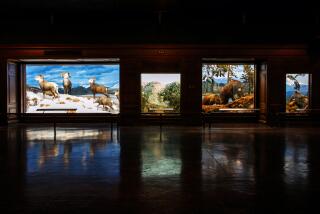Despite Past Success, Dinosaur Firm Feels It’s Time to Broaden Its Niche intro : Entertainment: Dinamation, whose customers--mainly museums--are growing tougher, looks for new kinds of robots to build.
- Share via
From a warren of offices next to a stable in San Juan Capistrano, Dinamation shepherds a herd of 500 dinosaurs around the world.
Robot dinosaurs, actually--the sort of machines that can stand nearly two stories high, roar, roll their eyes, gnash their teeth and otherwise delight crowds.
But things aren’t quite so amusing at the company itself: Dinamation International Corp. laid off nearly 25% of its staff since last year; its customers are starting to negotiate tougher, less profitable deals, and the company finds it difficult to procure loans to expand.
Dinamation caters to an unusual market: museums. And museums are having their own problems. Changes in federal tax law mean that private donations aren’t growing. Government and corporate giving hasn’t kept pace with inflation, and that money is spread ever thinner among a growing number of museums.
That’s where outfits such as Dinamation come in. To get more people in the door and to compete with television, amusement parks and the other distractions of modern life, museums have turned to jazzed-up traveling exhibits such as the robotic dinosaurs.
Some of the more august institutions may look down their nose at this “show biz” approach and sniff at charging museum visitors any admission at all. But many museums--particularly smaller ones in out-of-the-way cities--can’t afford to ignore the kinds of crowds that the dinosaurs often bring in.
“More museums are being forced to consider admission fees,” says Edward H. Able, executive director of the American Assn. of Museums, who estimates that half the nation’s 8,000 museums don’t charge admission.
Most traveling exhibits are mounted by other museums, which charge for them. One of the biggies was the 1970s King Tut exhibit, which brought in people who hadn’t set foot in a museum in years. Dinamation is one of the few companies that makes a living doing the same thing.
It works like this: Dinamation usually takes its costs off the top of the take from ticket sales, then splits the rest with the museum 50-50. A museum’s profits can vary wildly, depending on how many people the exhibit draws, the expenses the museum incurs in running the exhibit and other variables.
The museums are wising up to this relatively new game; they’ve started making tougher deals. Take the Cleveland Museum of Natural History, for instance. Instead of splitting the take with Dinamation, the museum will pay a flat rate to lease the dinosaurs and pocket the gate for itself for its next show, scheduled for the year after next.
Cleveland is a good example of another Dinamation problem: The first time the museum hosted the dinosaur exhibit in 1987, the turnout was phenomenal: 400,000 people visited the museum in the three months the show was there; only about 350,000 usually visit the museum in a year. But by the second time around, in 1989, the thrill was gone. Attendance was disappointing.
In short, the museum market is overdosing on dinosaurs. And that means Dinamation’s got to come up with something else to sell them. And that takes money.
While it was trying to decide what kind of robots to make next, the company laid off more than 30 workers since last fall from its Tustin factory. The savings will go into the large upfront costs for designing and building prototypes of complicated new animal robots.
For Dinamation, as for a lot of smaller companies, borrowing all that money would be tough in these recessionary times.
Actually, it was never terribly easy for Dinamation to borrow, the company says. It’s an unusual business, and its collateral--the dinosaurs--wander the world in 40-odd traveling exhibits--not the sort of sure bet that the average banker goes for. So, rather than borrowing, Dinamation says it has taken the slower route of growing mostly by using its surplus cash. “There are good revenues to be made in this business,” says Chris Mays, Dinamation president and chief executive. “But we’re not a runaway growth company of the sort you’d find in Silicon Valley. Our growth hasn’t been in a straight line.”
Mays, a youthful-looking, dapper man, was an airline pilot bored with the job in 1982 when a friend showed him a brochure from a Japanese company that made robotic dinosaurs. There might be money to be made here, they thought. Mays thought about who might want dinosaurs and came up with what turned out to be a pretty good answer: museums. He found five friends to put up $20,000 each to start a company that would market the dinosaurs in the United States.
At first, when the dinosaurs were a novelty, you could just unload them at the museum door and collect your money. But as the museums got more sophisticated in the late 1980s, they got a little pickier about matters such as whether the dinosaurs were as anatomically accurate as possible.
“Those creatures were robotically very nice,” says Doug Ashley, the company’s senior director of manufacturing operations, “but aesthetically they had some problems. Some of them looked like Godzilla.”
Complaints started coming in from the museums which, after all, are supposed to be in the education business, not part of the entertainment industry. Meanwhile, Mays had decided to go out on his own, hoping to make more money by building his own dinosaurs. In 1985, he split from his Japanese supplier, Kokoro Co., and began making dinosaurs.
Kokoro, a subsidiary of a Tokyo toy and candy maker called Sanrio Co., says it has more than 40 exhibits on the road too, about the same as Dinamation. Kokoro, which also makes vending machines, says its dinosaurs do about $10 million a year in revenue; privately held Dinamation claims about $12 million.
Now that the name of the game is anatomical accuracy, both companies snipe at each other’s robotic reptiles. And each has tied up big-name paleontologists to vouch for its dinosaurs’ pedigrees.
In fact, there’s still a good bit of debate about whether Dinamation has taken some liberties with its “creatures,” as the company calls them, to jazz up its exhibitions. Because paleontologists are basically working with only the bones of animals that have been extinct for millions of years, there’s some question, for instance, about the bright blues and reds with which it paints the skins of some of its dinosaurs. A more traditional view holds that dinosaurs probably had skins of dull green or black.
There’s also debate over the roars that the robots emit. Scientists can only guess, of course, at what sort of noises dinosaurs made--if any. Those sorts of liberties have kept both companies out of museums such as the venerable American Museum of Natural History in New York.
The museum’s curators “recognize the entertainment value and the role the dinosaurs play in stimulating people’s curiosity,” says Lowell Dingus, a paleontologist who’s now at work renovating the halls that house the museum’s large collection of fossils.
“We haven’t had the exhibit here, though, because whether dinosaurs had brightly colored skins or the (type of) noises they made are not things we want to make people think we know the answers to.”
What’s ahead for Dinamation? The company will decide soon whether to build more types of dinosaurs or branch out into robot whales or even giant insects. No easy undertaking, this. It takes nine months and a lot of money to go from a concept to a production model of a new creature. Once the assembly line starts turning them out, it still costs $30,000 to $40,000 apiece to make a typical dinosaur.
Although they’re built sturdy to require minimum maintenance and so they can be squeezed into trucks to make the trip from museum to museum, the machines’ average life span is only five or six years.
Competition promises to get tougher, with several additional companies said to be considering plunging into the museum exhibit business with their own dinosaurs.
As the museum business gets tougher, Dinamation is branching out into the theme park business by sinking millions of dollars into a small park in Hawaii that exhibits native Hawaiian plants and animals. This is to make sure the company itself doesn’t become extinct. The company eschews amusement parks, though, since it might tarnish the animals’ hard-won educational cachet and because the animals are a little tame for most amusement parks.
“In order to survive, we want to be more than the people who bring in the rubber dinosaurs,” says Mays.
More to Read
The biggest entertainment stories
Get our big stories about Hollywood, film, television, music, arts, culture and more right in your inbox as soon as they publish.
You may occasionally receive promotional content from the Los Angeles Times.










